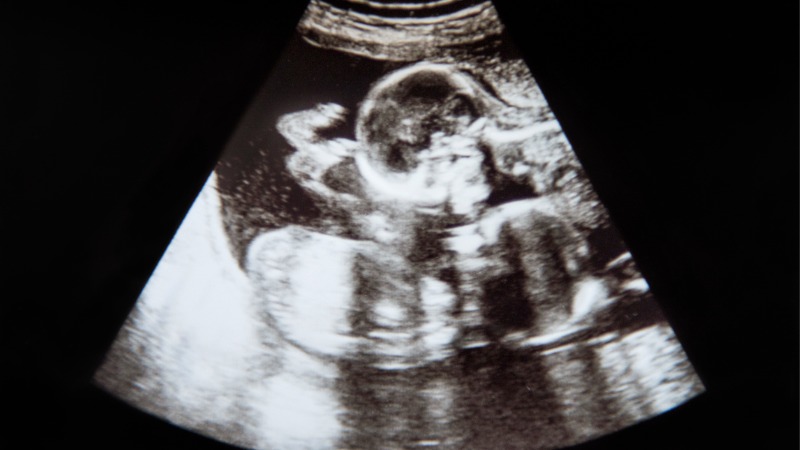Teen Pregnancy on Decline; New Sex Ed Policy Could Impede Trend

By Claudia Silva, El Paso Matters
Jacky Ponce of San Elizario was just 17 when she found out she was pregnant with her two daughters.
“When I went to my first (doctor’s) appointment and I found out it was twins, my mind just went crazy,” Ponce told El Paso Matters. “I was like, ‘What am I supposed to do with two kids? I’m so young.’”
Now, the freshly graduated high school senior is doing her best to love and raise her 5-month-old daughters, though she still looks back wishing she knew a little more about sex education and preventing unplanned pregnancies.
“At home, my mom would tell me, ‘If you’re going to have sex use protection.’ At school, we only took health in eighth grade. I feel like I didn’t have a lot of information about sex, you know?” Ponce said.
Ponce is one of a shrinking number of young moms as teen pregnancy rates in El Paso County have been on the decline over the last three decades. Recently released data shows that trend continued throughout the pandemic, with the number of teens in El Paso between the ages of 15 and 19 who gave birth to a child falling by about 10% between 2020 and 2021, according to Healthy Futures of Texas. In 2020, 804 teens in the county gave birth; that number was 724 in 2021.
Even with these advances, the nonprofit aimed at improving access to sexual and reproductive health is raising concerns that Texas’ newly implemented opt-in policy could prevent kids from attending schools’ already limited sex education classes and hinder some of that progress.
Starting this past school year, parents and guardians were required to submit a written permission slip if they wanted their child to receive sexual health and abuse prevention classes. Even before this new measure was implemented, sex ed was not required in Texas schools, but students could be automatically signed up to take the lessons as part of their health classes. In these cases, parents were given the option to opt their child out of sex ed lessons.
Senior director of policy and research for Healthy Futures of Texas, Jen Biundo, said she now worries this new opt-in policy could lead some of the state’s most vulnerable kids to miss out on sex ed.
“Many kids in our state live in situations that are less than ideal. They may not have parents or legal guardians living with them. We have a lot of kids in informal living situations, we have a lot of kids with parents who just aren’t able to be very present, and those are the kids that we’re most concerned about,” Biundo told El Paso Matters.
State lawmakers approved the policy change during the 2021 legislative session. Once it went into effect during the 2022-23 school year, Texas joined the small list of only five states that have an opt-in policy for sex ed and became the only one that requires parents to opt-in for abuse prevention instruction.
Now sex ed advocates worry that even if parents want their kids to take these classes, some may get left out simply because of the missed paperwork.
“We’re definitely concerned that parents might just not see the permission slip. They might forget about it. It could be written in a language that they don’t understand. Or maybe the kid doesn’t have parents that are around all the time. So a lot of reasons why a student can miss the permission slip and miss out on this really important information,” Biundo said.
Previous research on the topic has shown that opt-in policies have led to reduced student participation rates in sex ed classes, and have disproportionately affected at-risk youth.
A recent survey led by the University of Texas Health Science Center at Houston School of Public Health and Healthy Futures of Texas also found that most school leaders in the state view the policy as a barrier that prevents students from accessing sexual health and abuse prevention education.
School leaders expressed concern that an opt-in abuse prevention policy could put students who are facing abuse at home at heightened risk, according to the survey results.
“In a large percentage of the cases when we have abused children, it is the parent or guardian who’s the perpetrator. So we have a situation where children could be asking permission from their abusers to learn about abuse,” Biundo said.
Educators also worry that the measure could widen socioeconomic and health disparities among poor students and those who speak English as a second language.
“We have a really wide body of research that shows that low-income, at-risk families, families that English is not the first language – those are the families that tend to struggle the most with this type of paperwork, and it’s not that they’re actually opposed to it,” she said.
Teen pregnancy
Despite recent declines, El Paso’s teen birth rate was still 64% higher than the national average and 12% higher than the state average in 2021, according to a report from Healthy Futures of Texas.
That year, 724 teens between the ages of 15 and 19 gave birth in El Paso County, all conceived after the start of the COVID-19 pandemic. That’s roughly one teen birth every 12 hours.
The report also shows that 19% of those births were not the teens’ first child.
Biundo noted that structural issues like poverty, lack of access to health care and repeat births all contribute to high teen birth rates, something on which El Paso isn’t alone.
Since the U.S. Centers for Disease Control and Prevention began collecting data in 1991, Texas has always had a teen birth rate that was about 20% to 36% higher than the national average.
In 2021, Texas had the second highest rate of repeat teen birth in the county, according to Healthy Futures of Texas. That year 17% of births to teens in Texas were not their first.
One of the reasons El Paso and Texas’ teen birth rates are higher than average may come down to cultural barriers that discourage parents from talking to their kids about sexual health, said program manager for Project Vida, Reyna Castillo.
“I think one of (those reasons) would be because we’re prominently Hispanic Latinos, Mexicans living on the border. Sex education has always been seen as taboo. Like, ‘We don’t talk about that, de eso no se habla,’” Castillo said. “So because of that, a lot of kids don’t have medically accurate information to be able to make those decisions for themselves.”
Project Vida is a community nonprofit that offers various health and education services. This includes a school-based sex ed program, where the organization visits schools to teach about sexual health and a parenting program in San Elizario High School where teens learn to raise their kids.
Biundo said she has seen that Hispanic teens in Texas have higher birth rates than their white peers. Still, she noted that birth rates for both Black and Hispanic teens in El Paso are lower than in the rest of that state.
In 2021, the birth rate for teens between the ages of 15 and 19 in El Paso County was 25 per 1,000 for Hispanic teens compared to 14 per 1,000 for Black teens and 12 per 1,000 for White teens. That same year throughout Texas, teen birth rates were at 28 per 1,000 for Hispanic teens; 22 per 1,000 for Black teens; and 12 per 1,000 for White teens.
Sex ed may reduce teen pregnancy
Teen birth rates have declined nationally since 1991, according to the CDC. Though the reason for that decline is not entirely apparent, some experts say it could be because teens have more access to information about their sexual health than ever before.
“Whether kids are getting that from schools, from conversations with their parents, or even from the internet, they are learning about it more now,” Biundo said.
Carmen Zuniga, an outreach officer with Project Vida, said she has seen how access to information through comprehensive sex ed classes has helped lower teen birth rates in El Paso over the years.
“It’s steadily been decreasing and I think that has a lot to do with a lot of the different organizations in El Paso that are providing this education and empowering our youth to make healthier decisions,” Zuniga said.
Some evidence also suggests that the decline could be because teens today are less sexually active. A national survey found that the number of sexually active high school students dropped from 38% in 2019 to 30% in 2021. About 30 years ago, that rate was closer to 50%.
Still, Zuniga noted that by the time El Paso students enter their junior year of high school, more than half have had sex.
This coupled with rising STI rates led Project Vida to expand its sex ed services.
Zuniga said the organization initially focused on promoting healthy lifestyle choices and teaching students to identify risky behaviors. In 2015, the organization began receiving funding from the U.S. Department of Health and Human Services to implement an evidence-based teen pregnancy prevention program. That’s when the organization, which primarily works with students from the Socorro and Canutillo Independent School Districts, started shifting to addressing the needs of sexually active teenagers. This included referring them to local clinics and other resources — with a parent’s consent.
“The purpose was to have conversations with the youth and encourage them to talk with their parents and say, ‘I’m making a decision. I want to be sexually active, but I want to be safe,’” Zuniga said. “A lot of people think that when we talk about teen pregnancy, it’s all about just education and telling them not to have sex. The purpose of our program is to empower our youth for them to be safe if they choose to be sexually active, and to provide resources and opportunities for empowering the youth to choose abstinence.”
Some research has shown that these types of approaches could be successful at reducing teen pregnancy.
A 2022 quasi-experimental study examining counties with organizations that received federal funding for more comprehensive sex education, also known as abstinence-plus, had an overall reduction in the teen birth rate by over 3%. Still, the study states its findings are limited and more research still needs to be done on counties that have yet to receive this funding.
Ponce, the teen mom from San Elizario, said she knew what it was like to grow up around people who were tight-lipped about sexual health and what it was like to have limited access to sex ed. After taking part in Project Vida’s Positive Parenting Program, she now wants to make sure her daughters get that education and feel comfortable enough to talk about it when they get older.
“I want them to trust me so I can help them, you know. Because I don’t want them to go through the same thing I went through. I don’t want them to miss their high school years,” Ponce said.
—
This article first appeared on El Paso Matters and is republished here under a Creative Commons license.![]()
***
You Might Also Like These From The Good Men Project
 Compliments Men Want to Hear More Often Compliments Men Want to Hear More Often |
 Relationships Aren’t Easy, But They’re Worth It Relationships Aren’t Easy, But They’re Worth It |
 The One Thing Men Want More Than Sex The One Thing Men Want More Than Sex |
 ..A Man’s Kiss Tells You Everything ..A Man’s Kiss Tells You Everything |
Join The Good Men Project as a Premium Member today.
All Premium Members get to view The Good Men Project with NO ADS.
A $50 annual membership gives you an all access pass. You can be a part of every call, group, class and community.
A $25 annual membership gives you access to one class, one Social Interest group and our online communities.
A $12 annual membership gives you access to our Friday calls with the publisher, our online community.
Register New Account
Log in if you wish to renew an existing subscription.
Need more info? A complete list of benefits is here.
—
Photo credit: iStock.com
The post Teen Pregnancy on Decline; New Sex Ed Policy Could Impede Trend appeared first on The Good Men Project.
